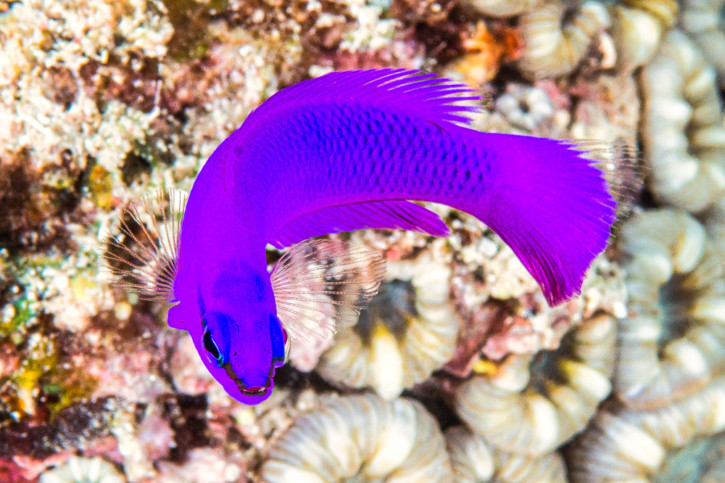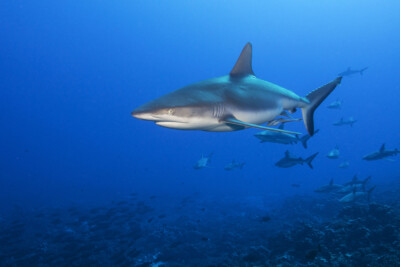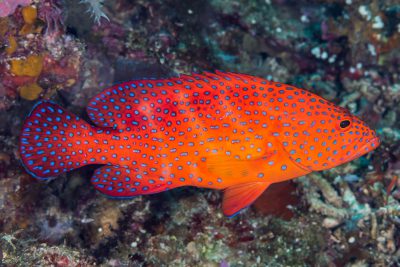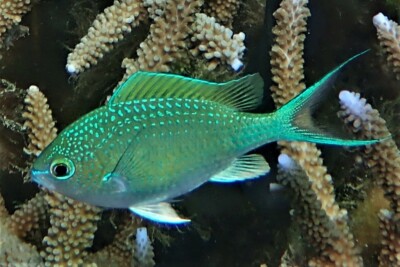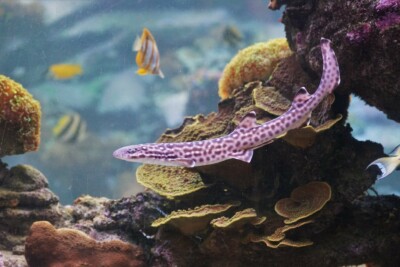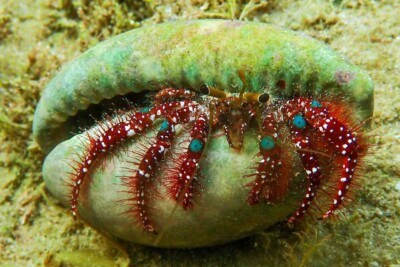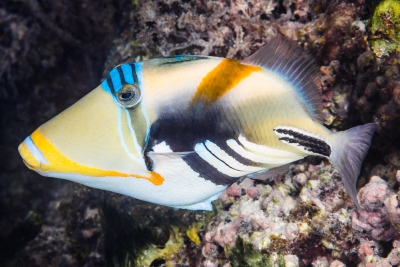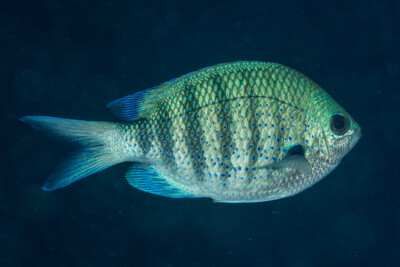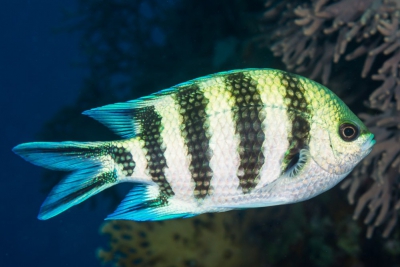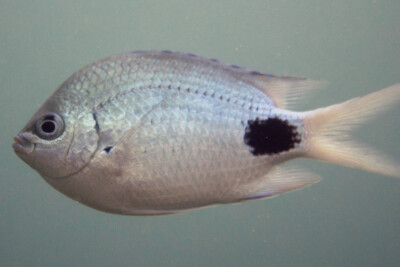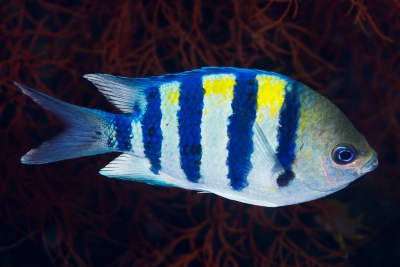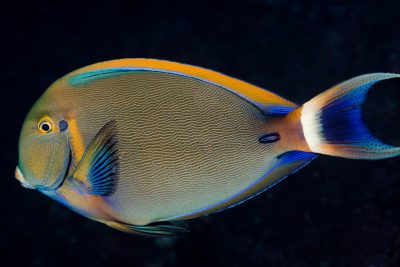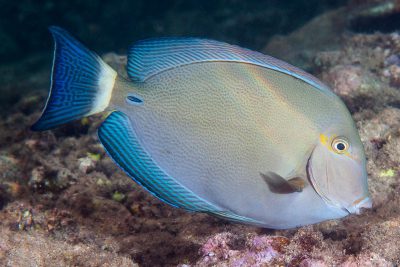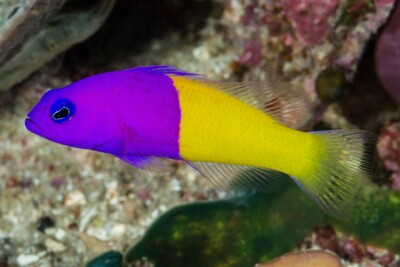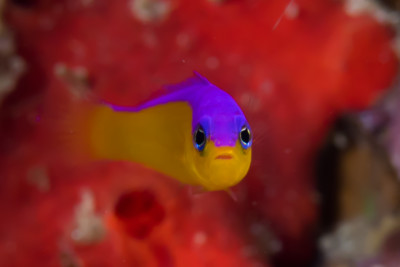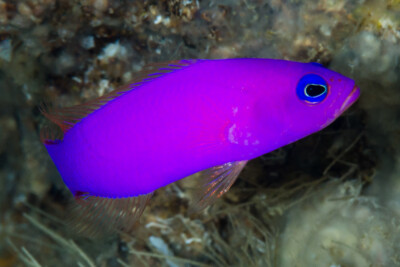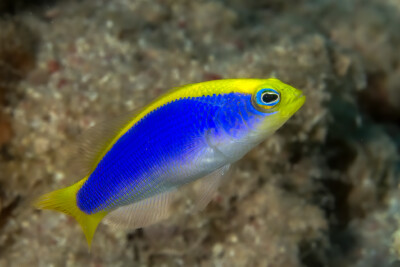orchid dottyback
| Scientific name | Pseudochromis fridmani |
|---|---|
| Descriptor | Klausewitz |
| Year of description | 1968 |
| IUCN category (World) | LC |
| Family | Pseudochromidae |
| Genus | Pseudochromis |
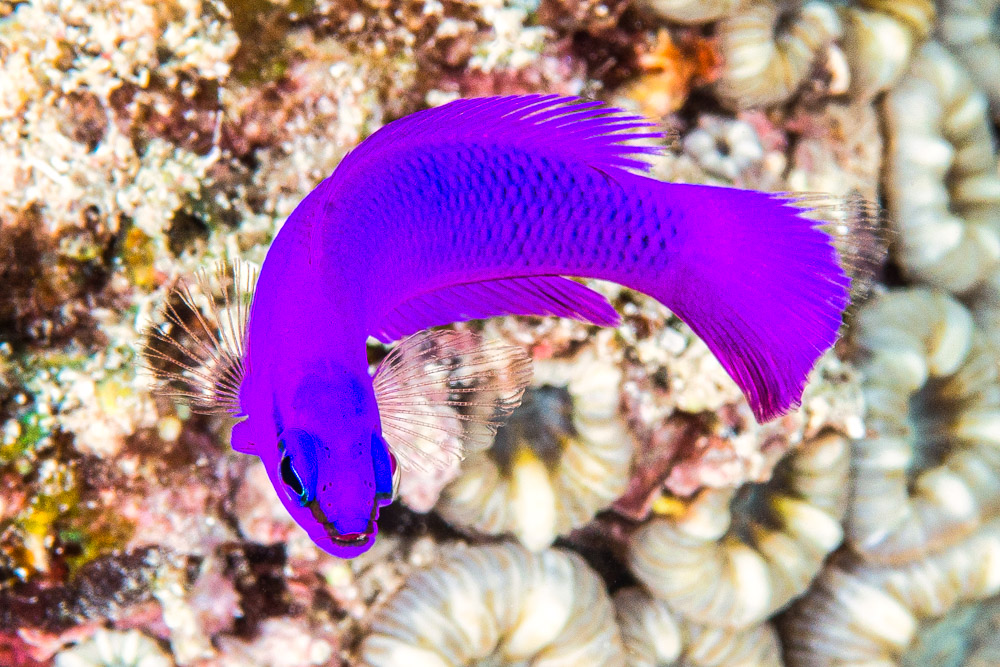

Introduction
The orchid dottyback is a small tropical fish found in the western part of the Indian Ocean. It inhabits shallow areas of coral reefs less than sixty meters deep.
Who is it?
Morphology
-
Average size5 cm
-
Maximum size6.3 cm
-
Longevity5 year
-
Average size5 cm
-
Maximum size6.3 cm
-
Longevity5 year
How to recognize This fish ?
The orchid dottyback has a bright purple coloration. Laterally compressed, it has an elongated shape.
A black band diagonally crosses the head, from the mouth to the back of the eye. The fins are translucent and the same color as the rest of the body. The dorsal fin is long and single, the anal fin is long, and the caudal fin is rounded.
Sexual dimorphism
Although dimorphism is not very visible in young fish, the shape of the fin in adults is different. The male has a less rounded fin than the female, which tends towards a lanceolate fin.
Behaviour & Life cycle
-
diet
-
Sociability
-
territorialNo
-
Way of livingdiurnal
The orchid dottyback is a lively but shy fish. It does not show aggressive behavior towards other fish. However, it is very aggressive towards its conspecifics.
Like its conspecifics, it is carnivorous and mainly feeds on aquatic microorganisms.
Reproduction
-
Reproductionovipare qui pond sur substrat caché
Pseudochromis fridmani is an oviparous fish that spawns on covered substrate. The male prepares the spawning site, then protects the eggs until they hatch.
Harmless species
This species does not pose any particular danger to humans in case of encounter in its natural environment.
Origin and distribution
What is its habitat?
Natural environment characteristics
-
Temperature22 - 26 °C
-
Depth1 - 60 m
Biotope presentation
This shy swimmer inhabits the rocks and corals of tropical reefs in the Indian Ocean.
Species of the same biotope
Main recommendations for fishkeeping
Deontology
In order to preserve wildlife, if you acquire this animal, it must not be released into the wild. See also, the Fishipedia charter.
Fishipedia supports the practice of responsible and environmentally friendly aquarium keeping. We encourage maintenance if it is motivated by a desire to understand the biological functioning of living things and if it is done with respect for animal life.
We believe that aquaristics is an opening to the discovery of aquatic environments, especially freshwater, and that this knowledge is necessary to better protect and respect these environments. Logically, we refute the compulsive purchase of animals that would not find a sufficient and / or adapted place in the host aquarium.
Our recommendationsThese tips apply to adult species from breeding. With regards to water conditions, wild species or close relatives must be kept under the same conditions as in their area of origin.
-
Min volume60 liters
-
Population minnot specified
-
Temperature22 - 26 °C
-
pH (acidity)8.2 - 8.4
CharacteristicsThe characteristics below apply for adult species. They correspond to an average of cases, validated in maintenance condition.
-
Difficulty breedingThe farming difficulty is relative. It depends on experiments already carried out with similar species. First, it takes into consideration the robustness of the species, the ease of recreation of a favorable environment and the general behaviour with the other inhabitants of the aquarium.moderate
General reminders
It is strongly advised to read the complete dedicated file and to get information on the feedbacks of maintenance of the envisaged animal, this to avoid any potential conflict whose end result is generally the death of the individual (or the other inhabitants). It is important not to overload your aquarium to limit pollution. This will make maintenance easier.
General reminder on maintenance datas
Le démarrage d'un aquarium est une partie primordiale pour l'équilibre et le bien-être des poissons. Lorsque l'on met en eau un aquarium, l'eau passe naturellement par un cycle biologique : le cycle de l'azote. Celui-ci dure environ trois semaines. Tous les 2 jours, nous vous conseillons de tester votre eau jusqu'à ce que le taux de nitrite soit à zéro pendant plusieurs jours d'affilée.
Pour accélérer ce cycle, vous pouvez utiliser un activateur de bactéries comme JBL Denitrol. Cette solution riche en bactéries vivantes et enzymes permet une mise en place rapide du cycle de l'azote. Les poissons peuvent alors être introduits plus rapidement.
Il est important de tester l'eau de son aquarium régulièrement pour maintenir un environnement sain pour les poissons et les autres habitants. Les tests d'eau permettent de mesurer les niveaux de différents paramètres tels que le pH, la dureté totale, ainsi que les taux de nitrates, de nitrites et d'ammoniaque.
Pour réaliser ces tests, vous pouvez utiliser des produits d'analyse spécialisés tels que JBL ProScan qui permet de réaliser un diagnostic de l'eau directement via un smartphone. Il existe également des coffrets de tests plus classiques de bandelettes, comme JBL PROAQUATEST.
En cas d’usage de l’eau du robinet, vous pouvez utiliser un conditionneur d’eau de type Biotopol de JBL pour éliminer les substances nocives comme le chlore, le cuivre, le plomb et le zinc. Les conditionneurs d'eau garantissent une meilleure santé aux poissons et une meilleure croissance des plantes.
Chlorine and chloramine are dangerous for the health of animals. Used to disinfect water, these agents are present in significant quantities in tap water. We recommend using an anti-chlorine agent every time you change the water. In addition to chlorine, treatments and medicines sold for aquarium use sometimes contain dangerous heavy metals in high doses.
Specific needs for the orchid dottyback
The orchid dottyback is a marine species which lives naturally at a temperature between 22 °C and 26 °C. For proper maintenance, the temperature should never exceed the 29°C for long periods. Nitrate levels should remain below 50mg/L. To keep the water clean and unpolluted, plan on changing 20% to 30% of the water volume each month. In seawater, it is also possible to remove nitrates using one of the following methods: Jaubert, denitrator on sulfur, biopeletts, vodka method.
The breeding of this species is accessible on condition of being well informed about its needs in aquarium . Any cohabitants must be chosen with care to avoid the loss of animals.
Cohabitation & Environment
In a community aquarium context, this species should be kept in a minimum volume of 60 liters.
Tips for feeding
This species can eat dry food (flakes, pellets), fresh food and frozen food. To avoid deficiencies, it is recommended to vary the types of food.
You should not overfeed your residents to avoid polluting the water. For most species, it is better to feed a few small portions each day rather than one large meal.
Reproduction protocol
-
egg-laying protectionYes
Hybridization risks
In general, it is advised not to mix several species of the same genus or different varieties of the same species, to avoid the risks of hybridization.
These animals might interest you
To go further
Sources & Contributions
Participation & Validation
The Fishipedia team and specialist contributors are committed to providing high-quality content. However, although the information comes from scientific sources or testimonials from specialists, the cards may contain inaccuracies.
Translation
Translation done with the valuable contribution of our translators, who make this information available to a wider audience. We sincerely thank them for their commitment.
Bibliographic references
Captive reproduction and embryonic development of the Orchid Dottyback (Pseudochromis fridmani) - Tânia Araújo - Catarina Mendes - Fábio Miranda - Catarina Manuel - Fábio Samouco - João Chambel - Paulo Maranhão - Marine and Environmental Sciences Centre, Portugal - 2016.
Scientific partners
Tags
Species of the same family
Same genus
Species of the same biotope
